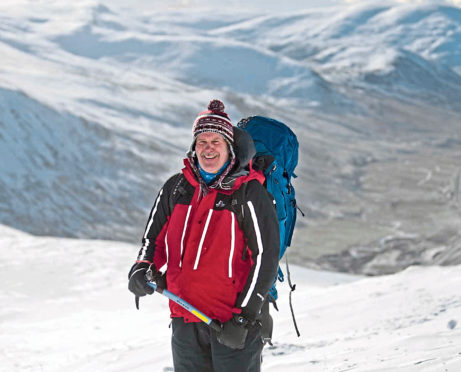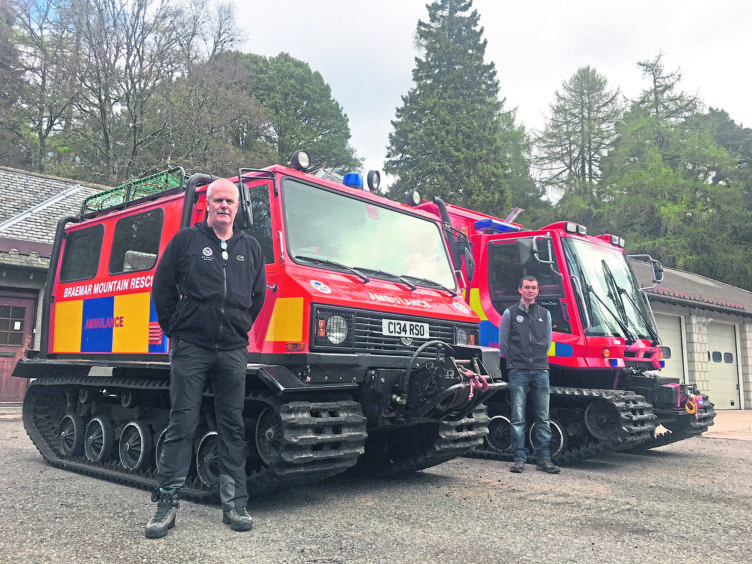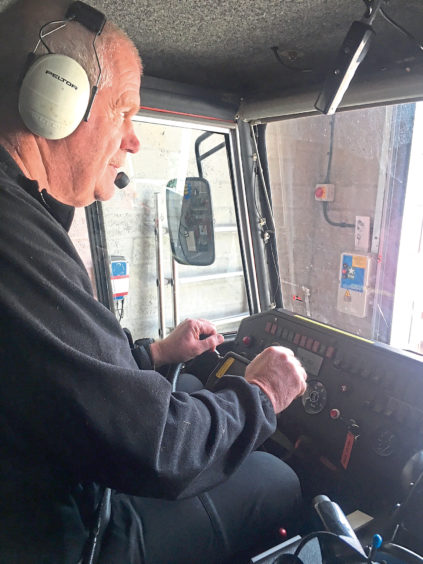Hidden up in the rugged and rural north, the Braemar Mountain Rescue Team are as much a part of the landscape as the rocky crags they protect. Philippa Gerrard was allowed through the snow gates for a closer look at life on the hill
A thunderous rumble breaks the stillness of a quiet spring morning in Braemar.
The ground seems to brace itself in anticipation as two six-ton machines come rolling out of a specially built garage, both thrumming their own steady heartbeat.
Between them, the two squat cubic-looking vehicles have a total of 28 wheels, encased in thick, heavy-duty tracks much built for a tank.
At the wheel of one is 61-year-old John Drysdale, who comes to a stop in front of me before leaning over to yank open the passenger door.
“Fancy a spin around the block?” he yells over the noise.
It’s off season, and whatever tourists are in the area are still enjoying bacon and eggs in the comfort of their hotel dining room.
I, meanwhile, am sitting up front in a Kassbohrer Flexmobile, one of only two thought to exist in Britain today.
The other is about 20 feet behind us as we trail through Braemar on a rather unique Highland safari.
Through ear defenders which have been synched up to a microphone, John explains to me that when the weather turns bleak, the “flexies” are worth their weight in gold.
“We’ve often passed snowploughs stuck in the snow in these,” he said.
“They are built to comfortably carry eight people, though we’ve had 42 folk crammed into one coming off a rescue once,” he chuckles.
“Though it’s best to avoid having the flexies on frozen ground, unless you want a six ton sledge coming at you.”
Without seemingly realising it, as we chat John keenly references his own experiences as part of the Braemar Mountain Rescue Team (BMRT).
That time he could physically see the cold veins of frostbite setting in on a colleague’s face – knowing the same was happening to him – or, more darkly, when a tourist with two young children made it out of a snowstorm with one less pair of little hands clutching his own after his daughter had perished.
John doesn’t regale these tales as evidence of his own achievements, merely an offhand comment here and there, as though he had done little more than some tiresome photocopying for a colleague or just taking the bin out with only his slippers on.
But having been a part of the BMRT for more than 30 years – over half his life – it’s not surprising that the ex-policeman has seen a few sights.
“I came to Braemar in 1987 when I was posted here with the police,” he said.
“On my very first morning I was asked if I wanted to join the police rescue team, who work alongside the volunteers to coordinate mountain rescues.
“I did that until I retired five years ago, and now I volunteer off my own back with the rest of the civvies.
“We’re a real band of brothers, it’s a good group to work with and I’d trust any of them with my life.”
Scattered throughout Ballater, Glenshee and Deeside, the 40 or so volunteers are not expert mountaineers or professional climbers, but rather a collection of accountants, teachers, offshore workers and doctors committed to keeping a watchful eye over the beautiful yet untamed Highlands.
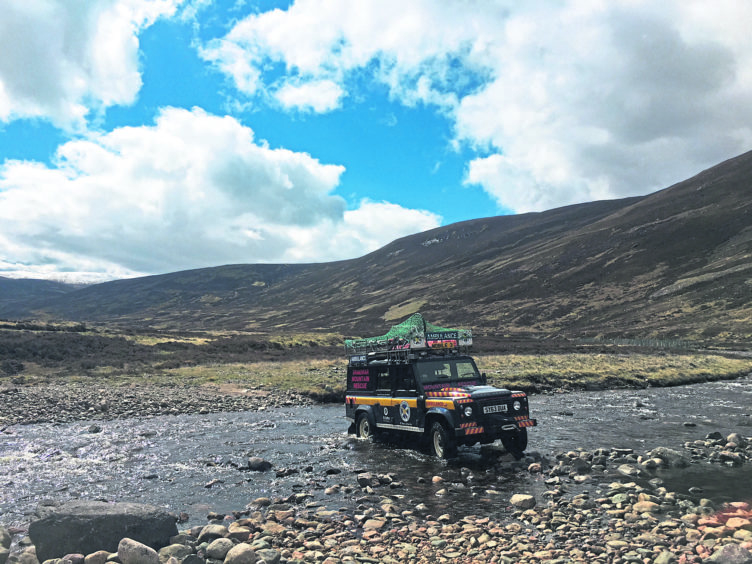
Their patch has a fluid border covering more than 700 square miles of the toughest terrain Scotland has to offer, including Ben Macdui, the second-highest mountain in the UK.
There are peaks and troughs in the call outs they receive.
“We are on call 24 hours a day, 365 days a year,” John said.
“I’ve been to the hill on New Year’s Eve, New Year’s Day, Boxing Day, my birthday…
“On Easter Monday this year we had three shouts in one day; a lady had hurt herself on the Cairn a’Mhaim ridge, a mountain biker had come off his bike and someone else was reported missing.
“All three were safe and sound in the end, but it is frightening how unprepared some people are.
“I’ve seen walkers climbing in just shorts and T-shirt with their phone for navigation.
“People underestimate the conditions.
“When you’re 4,000 feet up, the weather can be completely different.
“It takes minutes for a blizzard to roll in and suddenly you’re freezing, disoriented and your phone battery has died in the cold. Then what? You’re stuck.
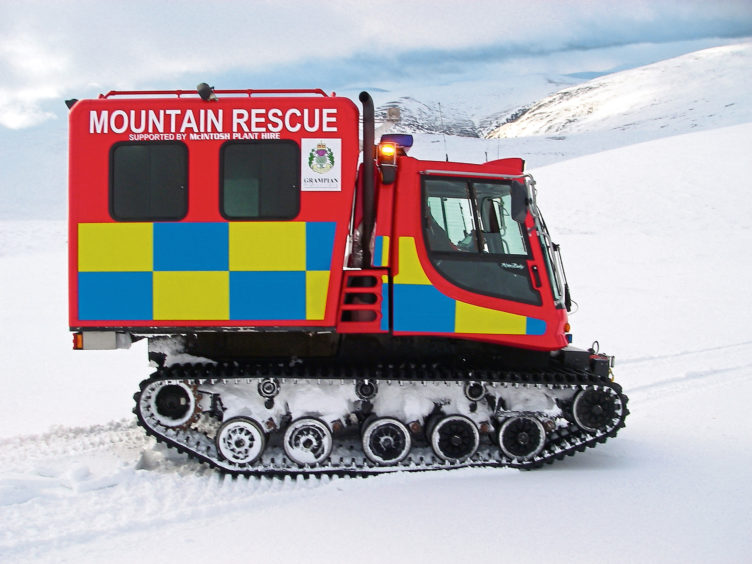 “They might just be on our doorstep, but people forget that the Highlands of Scotland are classed as a sub-arctic territory.”
“They might just be on our doorstep, but people forget that the Highlands of Scotland are classed as a sub-arctic territory.”
Despite the grave warnings John gives, I am amused to hear him refer to the Cairngorms region diminutively as “the hill”.
He also mentions “the flood”, in reference to Storm Frank in 2015, where the Mountain Rescue crew were – quite literally – out of their depth as they tried to rescue Ballater residents trapped in their homes.
“I had my wellies on but when I got out there to help the water was up to my chest,” said John, who easily breaks the six foot mark.
“And it was fast flowing too; we were very close to losing a couple of members of our team that day.
“It was scary, but we’ve added swift water courses to our training so next time we will be prepared.”
Volunteer Calum Halhead was just a trainee when the flooding hit.
Now 28, he is the youngest member of the current BMRT cohort, having moved north from Blairgowrie five years ago to work on the Invercauld Estate.
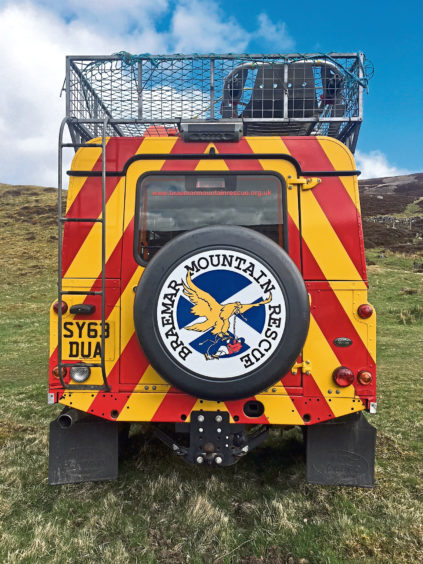 He was drawn to the area after learning that his grandfather was a gamekeeper on the very same estate some 50 years previously.
He was drawn to the area after learning that his grandfather was a gamekeeper on the very same estate some 50 years previously.
However, as well as taking on the tasks his grandfather once did, Calum has learned more about the land than many people double his age, taking part in daring rescues and enduring arctic conditions on the regular.
“I live just a couple of minutes away from our base in Braemar so I’m often the first one to arrive at call outs,” he said.
“It can be intimidating being the youngest – some of the guys here have so much experience, but they always share what they know and we’ve become close.
“Braemar’s not exactly got a great social scene, so it’s good to be friends with a bunch of like-minded people who are all up for having a laugh when we can.”
And it’s true, there’s an amazing camaraderie between team members as they smile, joke and poke fun at each other.
Perhaps their brotherly bonds are somewhat of an antidote to the often traumatic expeditions they find themselves on.
Dealing with death is a major part of the job and the team have been on more sobering rescues than they care to remember.
“My first major rescue was on Shelterstone Crag,” remembers Calum.
“It was an utterly epic day where we got helicoptered from our base up to near Aviemore.
“From there I spent 14 hours on the rock face trying to rescue an injured climber.
“Eventually we got him lowered down and stretchered on to the helicopter which airlifted him to hospital.
“Luckily he was alright, but with the helicopter gone we had to walk back through the night with all our kit.
“Not that it mattered to us of course, we were just happy to get the guy to safety.
“It’s those days where it really feels like we make a difference; he wouldn’t have survived if we weren’t there to help.”
Both Calum and John are wary picking their words when talking about the perilous situations members of the public sometimes get themselves into.
They are careful to never shame a casualty or lay blame with a trapped climber, instead choosing to understand that everyone makes mistakes.
As Calum says: “No one sets out to get rescued.”
However, although they don’t say it in so many words, it seems many of the incidents Calum, John and the rest of the team attend to could be avoided with a little bit of foresight.
When heading into the Cairngorms they recommend to bring extra layers of clothing, a map, a compass (“and know how to use it,” Calum adds), along with a torch and emergency shelter.
It might seem like overkill when it’s a balmy 15 degrees Celsius in Braemar itself, but the hills are unforgiving come summer or winter.
“In Scotland we are so lucky to have the freedom to roam,” said Calum.
“We are allowed to go anywhere at any time with a moment’s notice.
“But perhaps that should come with an element of education and responsibility.
“It’s a cold and lonely place on the hills after dark.”
The Braemar Mountain Rescue Association was formed in 1965 and is run almost exclusively on money from public donations.
Volunteers are always required and donations gratefully appreciated.
For more details see www.braemarmountainrescue.org.uk
